Related Research Articles

The University of Puerto Rico, often shortened to UPR, is the main public university system in the U.S. Commonwealth of Puerto Rico. It is a government-owned corporation with 11 campuses and approximately 44,200 students and approximately 4,450 faculty members. UPR has the largest and most diverse academic offerings in the commonwealth, with 472 academic programs of which 32 lead to a doctorate.

The University of Puerto Rico, Mayagüez Campus (UPRM) or Recinto Universitario de Mayagüez (RUM) in Spanish, is a public land-grant university in Mayagüez, Puerto Rico. The UPRM is the second-largest university campus of the University of Puerto Rico system, a member of the sea-grant, and the space-grant research consortia. In 2009, the campus population was composed of 12,108 students, 1,924 regular staff members, and 1,037 members of the education staff. In 2013, the student population remained relatively steady at 11,838, but the instructional faculty dropped to 684. In the second semester of 2019 around 12,166 students were enrolled. By the end of the academic year 2022-2023 there were 10,071 students enrolled. UPRM has been accredited by the Middle States Commission on Higher Education (MSCHE) since 1946.

The University of Puerto Rico, Río Piedras Campus is a public land-grant research university in San Juan, Puerto Rico. It is the largest campus in the University of Puerto Rico system in terms of student population and it was Puerto Rico's first public university campus.

The University of Puerto Rico-Humacao is a public college in Humacao, Puerto Rico. It is part of the University of Puerto Rico. Its campus is home to the UPRH Astronomical Observatory and the college graduates more majors in chemistry, physics, and mathematics than any other higher education institution on the island. UPRH has been accredited by the Middle States Commission on Higher Education (MSCHE) since 1965.
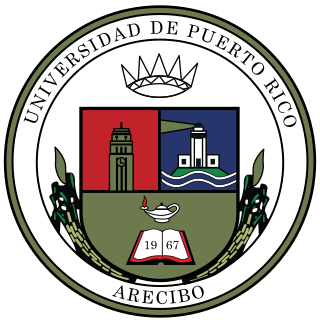
The University of Puerto Rico at Arecibo is a public college in Arecibo, Puerto Rico. It is part of the University of Puerto Rico. UPR-Arecibo was previously the Colegio Regional de Arecibo and Colegio Universitario Tecnológico de Arecibo.

The University of Puerto Rico at Carolina is a public college in Carolina, Puerto Rico. It is part of the University of Puerto Rico (UPR) and is better known as CRCA or CUNICA from its former names in Spanish of Colegio Regional de Carolina and Colegio Universitario de Carolina respectively.
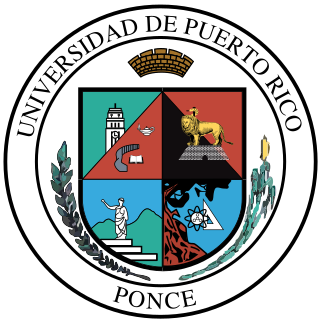
The University of Puerto Rico at Ponce is a public college in Ponce, Puerto Rico. It is the only campus of the University of Puerto Rico on the southern region of the island.
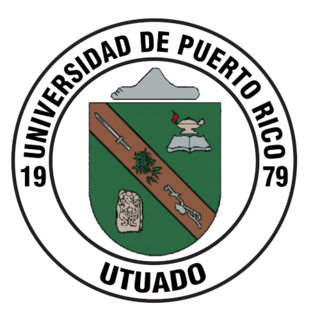
The University of Puerto Rico at Utuado is a public college in Utuado, Puerto Rico. Founded in 1979, it is the youngest of the campuses that compose the University of Puerto Rico system. UPR-Utuado is also known by its previous name Colegio Regional de la Montaña and its acronym "CORMO".
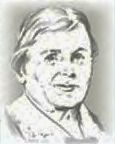
Ana Roqué de Duprey, also known as "Flor del Valle" for her work in botany, was an educator, scientist, suffragist, and one of the founders of the University of Puerto Rico. She studied botany, astronomy, geology, and meteorology with Agustín Stahl and contributed to these disciplines with her own studies and publications. Roqué also founded the first woman's suffrage organizations in Puerto Rico in 1917.

Jaime Benítez Rexach was a Puerto Rican author, academic and politician. He was the longest serving chancellor and the first president of the University of Puerto Rico. From 1973 to 1977, he served two terms in Congress as the Resident Commissioner of Puerto Rico.

Heinrich Klumb was a German architect who worked in Puerto Rico during the mid 20th Century.
The Puerto Rico Statehood Students Association (PRSSA) —Spanish: Asociación de Estudiantes Estadistas de Puerto Rico— is a Puerto Rican non-profit student organization dedicated to promoting statehood for Puerto Rico. It was founded in 1979, and remained active for two years, becoming inactive 1981–1993, active again 1993 to 1997, inactive once more 1997 to 2007, when it was reactivated once again.
The University High School, commonly referred to by its initials "UHS", in San Juan, Puerto Rico is a college preparatory laboratory high school operated by the Faculty of Education of the University of Puerto Rico. Located on the University of Puerto Rico, Río Piedras Campus, it provides education to approximately 514 students from 7th to 12th grade.
The 2010–2011 University of Puerto Rico strikes (UPR) refer to the student strikes which took place between May 2010 and June 2010 in ten of the university system's eleven constituent institutions, as well as the protests that occurred from October 2010 to February 2011.

Nu Sigma Beta Fraternity (ΝΣΒ) is a Puerto Rican fraternity. It was established in 1937 at the University of Puerto Rico by 10 students from diverse backgrounds. It quickly expanded and 86 years later, there are chapters and zones all over the island, Dominican Republic and the United States.
Luis Estrella-Martínez is an associate justice of the Supreme Court of Puerto Rico. Confirmed by the Senate on May 11, 2011, he took office on May 25, 2011, at the age of 39 and could serve for over 30 years until his mandatory retirement age of 70 on November 17, 2041.
Palmira N. Ríos is an Afro-Puerto Rican academic who has worked as a professor in New York, the Dominican Republic and Puerto Rico. She has served as a commissioner and president of the Puerto Rican Civil Rights Commission, the first person of color or woman to be appointed to the government body. After serving as the dean of the Graduate School of Public Administration for the University of Puerto Rico, she became the Dean of Academic Affairs for the Río Piedras Campus in 2015. The Bar Association of Puerto Rico honored Ríos with the Martin Luther King Jr.-Arturo Alfonso Schomburg Medal for her efforts to promote racial equality.
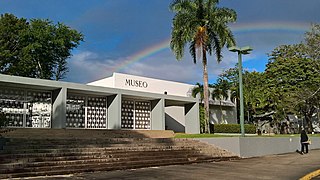
The Museum of History, Anthropology and Art of the University of Puerto Rico — often shortened to Museum of the UPR or MAHA — is a university museum dedicated to anthropology, archaeology and the history of art of Puerto Rico located on the grounds of the University of Puerto Rico, Río Piedras Campus. Officially dating to 1951, this museum is the oldest in Puerto Rico with its first collection being even older dating to 1914, donated by then Resident Commissioner Federico Degetau.
Nivia Aurora Fernández Hernández is a Puerto Rican dietetics and nutrition professor at the University of Puerto Rico, Río Piedras Campus. She has expertise in nutrition, gerontology, and higher education. She was the interim president of the University of Puerto Rico in 2017.
References
- ↑ Pacheco, Istra. "Decretan paro y huelga en la UPR". Primera Hora. Retrieved 29 March 2017.
- 1 2 Cordero, David. "Aprueban paro, marcha y huelga los estudiantes de la UPR Río Piedras". Metro (in Spanish). Retrieved 2021-05-26.
- ↑ Darmy Cortes (April 25, 2017). "The University of Puerto Rico Student Strike, Explained". Pasquines. Retrieved April 28, 2017.
- ↑ "UPR students vote to end two-month strike". Caribbean Business. 2017-06-05. Retrieved 2021-05-26.
- ↑ "Con Humacao, termina la huelga en el sistema UPR (video)". www.noticel.com. Retrieved 2021-05-26.
You can help expand this article with text translated from the corresponding article in Spanish. (February 2019)Click [show] for important translation instructions.
|